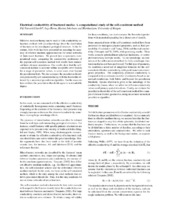| dc.contributor.author | Sævik, Pål Næverlid | eng |
| dc.contributor.author | Berre, Inga | eng |
| dc.contributor.author | Jakobsen, Morten | eng |
| dc.contributor.author | Lien, Martha | eng |
| dc.date.accessioned | 2014-12-15T09:19:22Z | |
| dc.date.available | 2014-12-15T09:19:22Z | |
| dc.date.issued | 2012 | eng |
| dc.identifier.issn | 1052-3812 | en_US |
| dc.identifier.uri | https://hdl.handle.net/1956/8923 | |
| dc.description.abstract | Effective medium theory can be used to link conductivity estimation methods with prior knowledge about the distribution of fractures in the investigated geological structure. In the literature, little work has been presented on assessing the accuracy of effective medium approximations for dense networks of finite-sized fractures. We present here a systematic computational study, comparing the conductivity predictions of the popular self-consistent method with results from numerical finite-element simulations. Our results show that the selfconsistent method is accurate within acceptable error bounds for a range of parameter values, in some cases even beyond the percolation limit. We also compare the percolation thresholds predicted by self-consistent theory with the thresholds obtained by a numerical percolation algorithm. For the cases we have studied, the percolation thresholds agree to a remarkable degree. | en_US |
| dc.language.iso | eng | eng |
| dc.publisher | Society of Exploration Geophysicists | en_US |
| dc.title | Electrical conductivity of fractured media: A computational study of the self-consistent method | en_US |
| dc.type | Journal article | |
| dc.type | Peer reviewed | |
| dc.date.updated | 2014-12-15T08:57:34Z | |
| dc.description.version | acceptedVersion | en_US |
| dc.rights.holder | Copyright 2012 SEG | en_US |
| dc.identifier.doi | https://doi.org/10.1190/segam2012-1026.1 | |
| dc.identifier.cristin | 996416 | |
| dc.source.journal | Society of Exploration Geophysicists. Expanded Abstracts with Biographies | |
